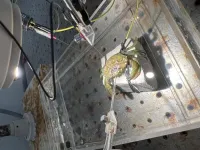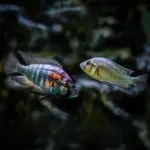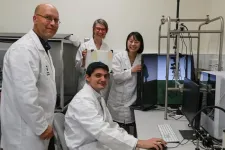(Press-News.org) Researchers from the University of Gothenburg are the first to prove that painful stimuli are sent to the brain of shore crabs providing more evidence for pain in crustaceans. EEG style measurements show clear neural reactions in the crustacean's brain during mechanical or chemical stimulation.
In the search for a better welfare of animals that we humans kill for food, researchers at the University of Gothenburg have chosen to focus on decapod crustaceans. This includes shellfish delicacies such as prawns, lobsters, crabs and crayfish that we both catch wild and farm. Currently, shellfish are not covered by animal welfare legislation in EU, but this might be about to change. For a good reason, according to researchers.
“We need to find less painful ways to kill shellfish if we are to continue eating them. Because now we have scientific evidence that they both experience and react to pain,” says Lynne Sneddon, zoophysiologist at the University of Gothenburg.
Several research groups have previously conducted a number of observational studies on crustaceans where they have been subjected to mechanical impact, electric shocks or acids to soft tissues such as the antennae. These crustaceans have reacted by touching the exposed area or trying to avoid the danger in repeated experiments, leading researchers to assume that they feel pain.
Pain receptors in the soft tissues
The researchers at the University of Gothenburg are the first to carry out neurobiological studies by measuring the activity in the brain of a shore crab, through an EEG style measurement.
“We could see that the crab has some kind of pain receptors in its soft tissues, because we recorded an increase in brain activity when we applied a potentially painful chemical, a form of vinegar, to the crab's soft tissues. The same happened when we applied external pressure to several of the crab's body parts,” says Eleftherios Kasiouras, PhD student at the University of Gothenburg and lead author of the study published in the journal Biology.
The activity of the central nervous system in the brain was measured in the crab when the soft tissues of claws, antennae and legs were subjected to some form of stress. The responses show that shore crabs must have some form of pain signalling to the brain from these body parts. The pain response was shorter and more powerful in the case of physical stress than in the case of chemical stress, which lasted longer.
Allowed to cut up alive
“It is a given that all animals need some kind of pain system to cope by avoiding danger. I don't think we need to test all species of crustaceans, as they have a similar structure and therefore similar nervous systems. We can assume that shrimps, crayfish and lobsters can also send external signals about painful stimuli to their brain which will process this information,” says Eleftherios Kasiouras.
The researchers point out that we need to find more humane ways to handle and even kill crustaceans. At present, it is allowed to cut up a crustacean alive, unlike the mammals we eat.
“We need more research to find less painful ways to kill shellfish,” says Lynne Sneddon.
Researchers from the University of Gothenburg are the first to prove that painful stimuli are sent to the brain of shore crabs providing more evidence for pain in crustaceans. EEG style measurements show clear neural reactions in the crustacean's brain during mechanical or chemical stimulation.
In the search for a better welfare of animals that we humans kill for food, researchers at the University of Gothenburg have chosen to focus on decapod crustaceans. This includes shellfish delicacies such as prawns, lobsters, crabs and crayfish that we both catch wild and farm. Currently, shellfish are not covered by animal welfare legislation in EU, but this might be about to change. For a good reason, according to researchers.
“We need to find less painful ways to kill shellfish if we are to continue eating them. Because now we have scientific evidence that they both experience and react to pain,” says Lynne Sneddon, zoophysiologist at the University of Gothenburg.
Several research groups have previously conducted a number of observational studies on crustaceans where they have been subjected to mechanical impact, electric shocks or acids to soft tissues such as the antennae. These crustaceans have reacted by touching the exposed area or trying to avoid the danger in repeated experiments, leading researchers to assume that they feel pain.
Pain receptors in the soft tissues
The researchers at the University of Gothenburg are the first to carry out neurobiological studies by measuring the activity in the brain of a shore crab, through an EEG style measurement.
“We could see that the crab has some kind of pain receptors in its soft tissues, because we recorded an increase in brain activity when we applied a potentially painful chemical, a form of vinegar, to the crab's soft tissues. The same happened when we applied external pressure to several of the crab's body parts,” says Eleftherios Kasiouras, PhD student at the University of Gothenburg and lead author of the study published in the journal Biology.
The activity of the central nervous system in the brain was measured in the crab when the soft tissues of claws, antennae and legs were subjected to some form of stress. The responses show that shore crabs must have some form of pain signalling to the brain from these body parts. The pain response was shorter and more powerful in the case of physical stress than in the case of chemical stress, which lasted longer.
Allowed to cut up alive
“It is a given that all animals need some kind of pain system to cope by avoiding danger. I don't think we need to test all species of crustaceans, as they have a similar structure and therefore similar nervous systems. We can assume that shrimps, crayfish and lobsters can also send external signals about painful stimuli to their brain which will process this information,” says Eleftherios Kasiouras.
The researchers point out that we need to find more humane ways to handle and even kill crustaceans. At present, it is allowed to cut up a crustacean alive, unlike the mammals we eat.
“We need more research to find less painful ways to kill shellfish,” says Lynne Sneddon.
END
Brain test shows that crabs process pain
2024-11-26
ELSE PRESS RELEASES FROM THIS DATE:
Social fish with low status are so stressed out it impacts their brains
2024-11-26
Social stress is bad for your brain. It’s a prime suspect in the accumulation of oxidative stress in the brain, which is believed to contribute to mental health and neurodegenerative disorders — but the mechanisms that turn social stress into oxidative stress, and how social status affects this, are poorly understood. By studying a highly social, very hierarchical fish species, cichlids, scientists have now found that social stress raises oxidative stress in the brains of low-status fish.
“We found that low rank was generally linked to higher levels of oxidative stress in the brain,” said Dr Peter Dijkstra of ...
Predicting the weather: New meteorology estimation method aids building efficiency
2024-11-26
Due to the growing reality of global warming and climate change, there is increasing uncertainty around meteorological conditions used in energy assessments of buildings. Existing methods for generating meteorological data do not adequately handle the interdependence of meteorological elements, such as solar radiation, air temperature, and absolute humidity, which are important for calculating energy usage and efficiency.
To address this challenge, a research team at Osaka Metropolitan University’s Graduate School of Human Life and Ecology—comprising Associate ...
Inside the ‘swat team’ – how insects react to virtual reality gaming
2024-11-26
Humans get a real buzz from the virtual world of gaming and augmented reality but now scientists have trialled the use of these new-age technologies on small animals, to test the reactions of tiny hoverflies and even crabs.
In a bid to comprehend the aerodynamic powers of flying insects and other little-understood animal behaviours, the Flinders University-led study is gaining new perspectives on how invertebrates respond to, interact with and navigate virtual ‘worlds’ created by advanced entertainment technology.
Published in the ...
Oil spill still contaminating sensitive Mauritius mangroves three years on
2024-11-26
Three years after bulk carrier MV Wakashio ran aground on a coral reef off Mauritius, spilling 1000 tonnes of a new type of marine fuel oil, Curtin University-led research has confirmed the oil is still present in an environmentally sensitive mangrove forest close to important Ramsar conservation sites.
Lead researcher Dr Alan Scarlett, from Curtin’s WA Organic and Isotope Geochemistry Centre in the School of Earth and Planetary Sciences, said the chemical ‘fingerprint’ of the oil found ...
Unmasking the voices of experience in healthcare studies
2024-11-26
Researchers are calling for a formal process that recognises and acknowledges the invaluable contributions of those with lived experience in healthcare research.
New research by Flinders University published in the Patient Education and Counselling journal exposes underlying issues in academic engagement and calls for better processes to credit those with lived experiences.
“With the growing awareness of the importance of diversity and inclusion in research, it is time for the research community to monitor not only how often, but also how well people with lived experience are involved,” says Associate Professor Elizabeth Lynch.
Associate Professor Lynch from the College of ...
Pandemic raised food, housing insecurity in Oregon despite surge in spending
2024-11-26
Despite a heavy infusion of public and private support during the COVID-19 pandemic, Medicaid and Medicare beneficiaries in Oregon reported that housing and food insecurity shot up during the onset of the pandemic in March of 2020 — and their basic needs remained in doubt through at least the end of the following year.
The survey data were reported in a study led by Oregon Health & Science University and published today in the Annals of Family Medicine.
The Oregon study provides a state-specific dimension to a nationwide survey ...
OU College of Medicine professor earns prestigious pancreatology award
2024-11-26
Min Li, Ph.D., a George Lynn Cross Professor of Medicine, Surgery and Cell Biology at the University of Oklahoma College of Medicine and Associate Director for Global Oncology at OU Health Stephenson Cancer Center, will receive the 2024 Palade Prize from the International Association of Pancreatology.
The Palade Prize, the IAP’s most distinguished award for research excellence, recognizes Li’s contributions to the field of pancreatology, which is dedicated to discovering new methods of identifying, diagnosing and treating diseases of the pancreas such as pancreatic ...
Sub-Saharan Africa leads global HIV decline: Progress made but UNAIDS 2030 goals hang in balance, new IHME study finds
2024-11-26
**Embargo: 23.30 [UK time], 6:30 p.m. [ET], 3:30 p.m. [PT], Monday, November 25 2024**
In contrast, the percentage of the population without a suppressed level of HIV (PUV) increased by 116.1% in Central Europe, Eastern Europe, and Central Asia from 2003 to 2021.
The study authors are issuing recommendations to invigorate the global HIV response across global public health programs dedicated to HIV control and expansion of prevention services.
The Institute for Health Metrics and Evaluation (IHME) has published a new study in The Lancet HIV journal that revealed significant progress in the global fight against HIV/AIDS, alongside ...
Popular diabetes and obesity drugs also protect kidneys, study shows
2024-11-26
The biggest and most comprehensive analysis of glucagon-like peptide-1 (GLP-1) receptor agonists on kidney and cardiovascular outcomes shows they have significant benefits in people with and without diabetes.1 Findings were published today in The Lancet Diabetes & Endocrinology.
Originally developed to treat diabetes, GLP-1 receptor agonists mimic the action of a hormone called glucagon-like peptide 1, which stimulates insulin production and lowers blood sugar levels. More recently, they have emerged as effective treatments for obesity - slowing digestion, ...
Stevens INI receives funding to expand research on the neural underpinnings of bipolar disorder
2024-11-25
Leila Nabulsi, PhD, a postdoctoral researcher in computational neuroscience at the Keck School of Medicine of USC’s Mark and Mary Stevens Neuroimaging and Informatics Institute (Stevens INI) has received funding to expand research on the neurocircuitry that underlies bipolar disorder. Nabulsi was awarded the prestigious 2025 NARSAD Young Investigator Grant from the Brain & Behavior Research Foundation, a highly competitive grant that provides early-career researchers with crucial pilot funding to pursue new avenues in ...






